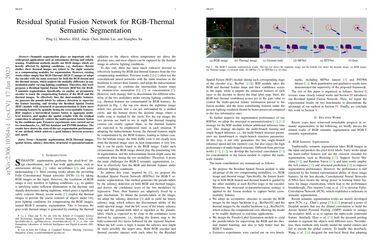Residual Spatial Fusion Network for RGB-Thermal Semantic Segmentation
Semantic segmentation plays an important role in widespread applications such as autonomous driving and robotic sensing. Traditional methods mostly use RGB images which are heavily affected by lighting conditions, \eg, darkness. Recent studies show thermal images are robust to the night scenario as a compensating modality for segmentation. However, existing works either simply fuse RGB-Thermal (RGB-T) images or adopt the encoder with the same structure for both the RGB stream and the thermal stream, which neglects the modality difference in segmentation under varying lighting conditions. Therefore, this work proposes a Residual Spatial Fusion Network (RSFNet) for RGB-T semantic segmentation. Specifically, we employ an asymmetric encoder to learn the compensating features of the RGB and the thermal images. To effectively fuse the dual-modality features, we generate the pseudo-labels by saliency detection to supervise the feature learning, and develop the Residual Spatial Fusion (RSF) module with structural re-parameterization to learn more promising features by spatially fusing the cross-modality features. RSF employs a hierarchical feature fusion to aggregate multi-level features, and applies the spatial weights with the residual connection to adaptively control the multi-spectral feature fusion by the confidence gate. Extensive experiments were carried out on two benchmarks, \ie, MFNet database and PST900 database. The results have shown the state-of-the-art segmentation performance of our method, which achieves a good balance between accuracy and speed.
PDF Abstract| Task | Dataset | Model | Metric Name | Metric Value | Global Rank | Benchmark |
|---|---|---|---|---|---|---|
| Thermal Image Segmentation | MFN Dataset | RSFNet (ResNet-101) | mIOU | 56.2 | # 17 |





 PST900
PST900
